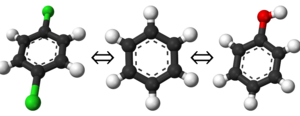Bennett Acceptance Ratio
| Free Energy Fundamentals |
|---|
 |
|
Methods of Free Energy Simulations
|
| Free Energy How-to's |
|---|
 |
The Bennett Acceptance Ratio (BAR) is one of the earliest free energy methods which draws on data from multiple states to estimate the free energy difference; This method has significantly improved results over EXP. Both EXP and TI require the ensemble average from a single state to estimate free energies. Although TI needs the derivatives at state [math]\displaystyle{ k }[/math], it does not require the configurations from any neighboring state; BAR however, requires configuration information from two states to estimate free energy differences.
BAR works under the principal that at the same configuration, [math]\displaystyle{ \vec{q} }[/math], at two separate states, [math]\displaystyle{ i }[/math] and [math]\displaystyle{ j }[/math], there is a pathway connecting the two potentials and a difference of [math]\displaystyle{ \Delta U_{ij}(\vec{q}) }[/math]. Because the states are in the same configuration, there is a exact relationship between the distributions of potential energy differences [math]\displaystyle{ \Delta U_{ij}(\vec{q}) }[/math] of states sampled from [math]\displaystyle{ i }[/math] and [math]\displaystyle{ \Delta U_{ji}(\vec{q}) }[/math] the distribution of potential energy differences sampled from the state [math]\displaystyle{ j }[/math].[1]. Since its an exact function of distributions, statistics can be applied to find the optimal way to use the information between two states, improving the free energy estimate. This is where Bennett started his derivation and, since he was the first to derive this, the method was named after him.[2]
Derivation
This derivation starts from a slightly modified version of the core free energy equation. Taking the properties of expectation values, we can write the free energy difference as
- [math]\displaystyle{ \Delta A_{ij} = -k_{B} T \ln \frac{Q_j}{Q_i} = k_{B}T \ln \frac{\left\langle\alpha(\vec{q}) \exp[-\beta \Delta U_{ij}(\vec{q})]\right\rangle_j}{\left\langle\alpha(\vec{q}) \exp[-\beta \Delta U_{ji}(\vec{q})]\right\rangle_i} }[/math]
Citation Test
Original citation is up above Testing citation robustness.[2] Placeholder to duplicate the citation [2]
References
- ↑ Crooks, G. E. (2000) Path-ensemble averages in systems driven far from equilibrium. Phys. Rev. E 61, 2361–2366.
- ↑ 2.0 2.1 2.2 Bennett, C. H. (1976) Efficient Estimation of Free Energy differences from Monte Carlo Data. J. Comput. Phys. 22, 245–268. - Find at Cite-U-Like Cite error: Invalid
<ref>tag; name "BennettPaper" defined multiple times with different content